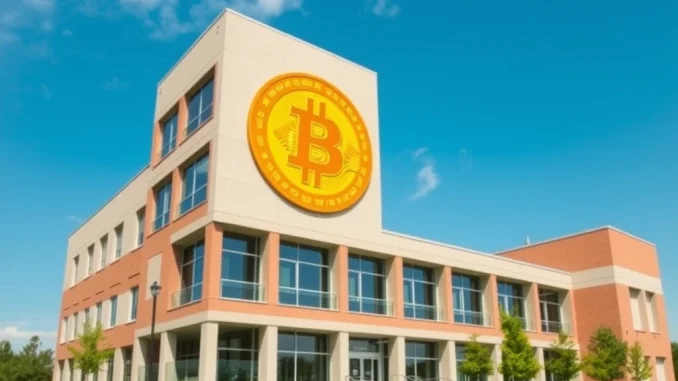
In a groundbreaking move that signals a significant shift in the integration of digital currencies into mainstream sectors, Lomond School in the UK has become the first educational institution to accept Bitcoin for fee payments. Reported by Bitcoin Magazine on X, this bold decision not only positions Lomond School at the forefront of innovation but also sparks a crucial conversation about the future of finance in education. Are we witnessing the dawn of a new era where cryptocurrency payments become commonplace in our schools? Let’s delve into this exciting development and explore what it means for students, parents, and the broader adoption of Bitcoin.
Why is Lomond School Embracing Bitcoin Adoption?
Lomond School’s decision to embrace Bitcoin adoption is multifaceted, reflecting a forward-thinking approach to finance and technology. Here’s a breakdown of the potential motivations behind this pioneering step:
- Future-Proofing Finances: By accepting Bitcoin, Lomond School is positioning itself ahead of the curve, acknowledging the growing importance of digital assets in the global economy. This proactive approach demonstrates a commitment to innovation and adaptability in a rapidly changing financial landscape.
- Catering to a Global Community: Cryptocurrency payments transcend geographical boundaries, offering a seamless payment solution for international students and families. This move can broaden Lomond School’s appeal to a global audience who are already comfortable with digital currencies.
- Building a Bitcoin Reserve: Beyond just accepting payments, Lomond School’s plan to build a Bitcoin reserve is particularly noteworthy. This suggests a long-term belief in the value and potential of Bitcoin as a store of value, aligning with a growing trend among institutions and corporations to diversify their reserves with digital assets.
- Educational Opportunity: Embracing Bitcoin provides a unique educational opportunity for students. It allows the school to integrate real-world examples of blockchain technology and digital finance into its curriculum, preparing students for a future where these technologies are increasingly prevalent.
The Benefits of Cryptocurrency Payments in Education
The integration of cryptocurrency payments in education, as pioneered by Lomond School, offers a range of potential benefits:
| Benefit | Description |
|---|---|
| Lower Transaction Fees | Compared to traditional banking systems, cryptocurrency transactions can often involve significantly lower fees, especially for international payments. This can translate to cost savings for both the school and parents. |
| Faster Transactions | Digital currency transactions are typically faster than traditional bank transfers, which can take several days to clear, especially across borders. This speed can streamline payment processes and improve efficiency. |
| Increased Transparency | Blockchain technology provides a transparent and auditable record of transactions. This enhanced transparency can improve accountability and trust in financial dealings. |
| Financial Inclusion | Bitcoin and other cryptocurrencies can offer access to financial services for individuals in regions with limited banking infrastructure. Accepting crypto payments can broaden access to education for students from these areas. |
Navigating the Challenges of Digital Currency in Schools
While the move towards accepting digital currency is innovative, it’s important to acknowledge the challenges that come with it. What hurdles might Lomond School and other educational institutions face?
- Volatility of Bitcoin: The price of Bitcoin is known for its volatility. Managing a Bitcoin reserve and dealing with tuition payments in a volatile currency requires careful financial planning and risk management strategies.
- Regulatory Uncertainty: The regulatory landscape for cryptocurrencies is still evolving globally. Schools accepting Bitcoin need to navigate varying and sometimes unclear regulations in different jurisdictions.
- Technological Infrastructure and Expertise: Implementing cryptocurrency payments requires setting up the necessary technological infrastructure and ensuring staff are trained to handle these new systems. This includes secure wallets, payment processing systems, and understanding blockchain technology.
- Public Perception and Education: There’s still a learning curve for many people regarding cryptocurrencies. Schools might need to educate parents and the wider community about Bitcoin and address any concerns or misconceptions.
Lomond School: Setting a New Precedent for UK Schools?
Lomond School’s foray into Bitcoin is more than just a news story; it’s a potential turning point for how educational institutions in the UK and globally might approach finance in the digital age. Will other schools follow suit? Here’s what we can expect:
- Increased Interest from Other Institutions: Lomond School’s pioneering move is likely to pique the interest of other schools, particularly those with a focus on innovation or a significant international student body. We may see more educational institutions exploring cryptocurrency payments in the near future.
- Catalyst for Regulatory Clarity: As more institutions begin to engage with cryptocurrencies, it could prompt regulators to provide clearer guidelines and frameworks for digital asset use in the education sector.
- Enhanced Curriculum Development: The adoption of Bitcoin can encourage schools to develop more comprehensive curricula around digital finance, blockchain technology, and the future of money, equipping students with essential skills for the evolving job market.
Actionable Insights: Is Bitcoin Right for Your School or Family?
For educational institutions considering following Lomond School’s lead, and for parents exploring cryptocurrency payments for school fees, here are some actionable insights:
- Conduct Thorough Research: Understand the benefits and risks associated with Bitcoin and cryptocurrency payments. Assess the technological, regulatory, and financial implications for your specific context.
- Start Small and Learn: Begin by accepting Bitcoin for a small portion of fees or for specific services. This allows for a gradual learning process and minimizes potential risks during the initial phase.
- Invest in Education and Training: Educate staff, parents, and students about digital currency and blockchain technology. Provide training on using secure wallets and payment systems.
- Seek Expert Advice: Consult with financial and legal experts who specialize in cryptocurrencies to ensure compliance and develop sound financial strategies for managing digital assets.
Conclusion: A Bold Step into the Future of Finance
Lomond School’s decision to accept Bitcoin and build a Bitcoin reserve is a bold and revolutionary step that positions them as a leader in educational innovation. This move not only streamlines payment processes and potentially reduces costs but also provides invaluable learning opportunities for students and sets a precedent for other institutions worldwide. As cryptocurrency adoption continues to grow, Lomond School’s pioneering spirit may well inspire a wave of digital transformation in the education sector, paving the way for a future where digital currency is seamlessly integrated into all aspects of our lives. The journey of Bitcoin in education has just begun, and Lomond School is leading the charge.



